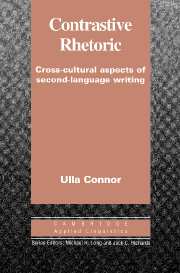Book contents
- Frontmatter
- Contents
- Series editors' preface
- Preface
- I PRELIMINARIES; EARLY PHASES OF THE FIELD
- II INTERFACES WITH OTHER DISCIPLINES
- III IMPLICATIONS OF CONTRASTIVE RHETORIC
- 9 Methods of research in contrastive rhetoric
- 10 Conclusion: Implications and research directions
- References
- Author index
- Subject index
9 - Methods of research in contrastive rhetoric
Published online by Cambridge University Press: 05 October 2012
- Frontmatter
- Contents
- Series editors' preface
- Preface
- I PRELIMINARIES; EARLY PHASES OF THE FIELD
- II INTERFACES WITH OTHER DISCIPLINES
- III IMPLICATIONS OF CONTRASTIVE RHETORIC
- 9 Methods of research in contrastive rhetoric
- 10 Conclusion: Implications and research directions
- References
- Author index
- Subject index
Summary
Studies of contrastive rhetoric, like a great deal of ESL research, have been interdisciplinary, reflecting the background and research training of the particular researcher. Linguistics, education, discourse analysis, sociolinguistics, and psycholinguistics have affected research approaches. Linguistics has provided tools for the structural analysis of texts, education and psychology have encouraged quantitative experimental methods, and sociolinguistic and anthropological investigations have favored qualitative research methods such as case studies and ethnographies. Early contrastive rhetoric was deeply embedded in an analysis influenced by structural linguistics. More recent contrastive research has been heavily influenced by quantitative and qualitative approaches derived from education, anthropology, and the other disciplines mentioned above.
Guidance from studies of composition pedagogy
Case studies, ethnographies, interviews, and text analyses are often labeled “qualitative” studies, whereas experiments and large-scale surveys are considered quantitative research. Books about research design and methods that explain the distinctions, such as Johnson's Approaches to Research in Second Language Learning (1992), are available for the second language teacher and researcher. For the researcher in contrastive rhetoric, treatments of research design by composition specialists may be more relevant. Three recent books devoted to the evolving design of composition research are Lauer and Asher's Composition Research: Empirical Designs (1988), Kirsch and Sullivan's Methods and Methodology in Composition Research (1992), and Hayes et al.'s Reading Empirical Research Studies: The Rhetoric of Research (1992). According to these sources, there is a healthy debate about methodology in composition studies, composition experts agree about the importance of multiple approaches in their research, hence historical, linguistic, philosophical, and rhetorical approaches are all prevalent.
- Type
- Chapter
- Information
- Contrastive RhetoricCross-Cultural Aspects of Second Language Writing, pp. 153 - 165Publisher: Cambridge University PressPrint publication year: 1996



